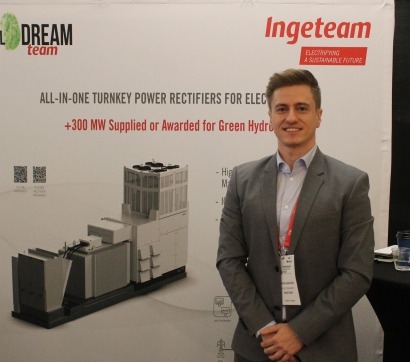
“It just seems like a natural opportunity for us,” Javier Sanchez, an engineer and project manager said while attending this week's Hydrogen Americas 2023, an exhibition and hydrogen energy summit held at the Ronald Reagan Building and International Trade Center in Washington, DC.
“We have an inverter that works phenomenally well for solar applications, and our thinking was, 'Why don't we use the same technology and produce a rectifier that can take power from the grid or from a green source, like a solar PV farm , and supply it to the companies that will need it to prosper in the hydrogen market?'”
“It's a case of building on what you know,” Sanchez continued. “We harnessed the knowledge we already had to build a rectifier tailor-made to supply electrolyzer manufacturers with the DC power supply they need to meet their needs.”
While there are a number of ways to draw hydrogen out of its natural state and use it for power, the most widely used method is electrolysis, a process that uses electricity to split water into hydrogen and oxygen. This reaction takes place in a unit called an electrolyzer.
Ingeteam now has three different machines geared toward the hydrogen market, all under the INGECON H2 banner.
The first is an electrolyzer rectifier based on insulated-gate bipolar transistor technology, which enables AC-to-DC power conversion with no need of any additional harmonic filters or STATCOM units.
According to a fact sheet Sanchez was distributing at the summit and trade show, the converters themselves are low power consumers due to efficiencies built into their power supply boards.
At the same time, this rectifier has been designed to facilitate a direct close-coupled connection with a medium voltage/low voltage transformer.
These rectifiers also feature several power stacks, allowing a connection of the DC output to one or several electrolyzers working independently.
Ingeteam's second unit is a medium voltage electrolyzer rectifier power station that integrates all the necessary elements to develop a large-scale hydrogen electrolysis plant.
Known as the FSK E60000/E12000 power station, the unit is billed as a compact, customizable and flexible solution that can be configured to suit any customer's unique requirements.
In addition, all the equipment, which is supplied on top of the same skid platform, is suitable for outdoor installation, so there is no need for any kind of housing.
Finally, there's the INGECON H2 D-lyzer, a DC converter that feeds power to electrolyzers directly from a solar PB plant, enabling true green hydrogen production.
“On top of that, we are leveraging our existing supply chain for solar and storage to drive costs down for hydrogen, and that's really good,” Sanchez said.
“The shift [from solar to hydrogen] is easy for us,” he said, adding, “because we have the supply chain, we have the knowledge, and we have the quality assurance department that can track all of the different components that we are putting in. So I think we have the perfect blend to have success in this market.”
Asked for his assessment of the current US hydrogen market, a sector that got a substantial financial boost from President Joe Biden’s signing of the Inflation Reduction Act last year, Sanchez likened it to “where solar power was in the US 10 years ago.”
“We’re at the very beginning when it comes to the US hydrogen sector, but you know, big things happen when you have the support of lawmakers,” he said. “When it comes to solar, we’ve seen exponential growth here, and I expect the same with hydrogen.
“Thanks to the Inflation Reduction Act, there are actually grants and tax credits and other aids available for project developers, and on the whole, there are a lot of policies in place here in the US that are favoring the introduction of hydrogen into the clean energy market,” Sanchez continued.
“Right now, I think there are something like 200 different hydrogen projects in development across the United States, we are in touch with the main players in the market, and we see the growth potential for us in this market as being very high in the coming years,” he said.
“So we are ready. “We are ready for the challenges, we are ready for the opportunities, and we are ready for the large-scale deployment of hydrogen in the United States,” Sanchez said.

